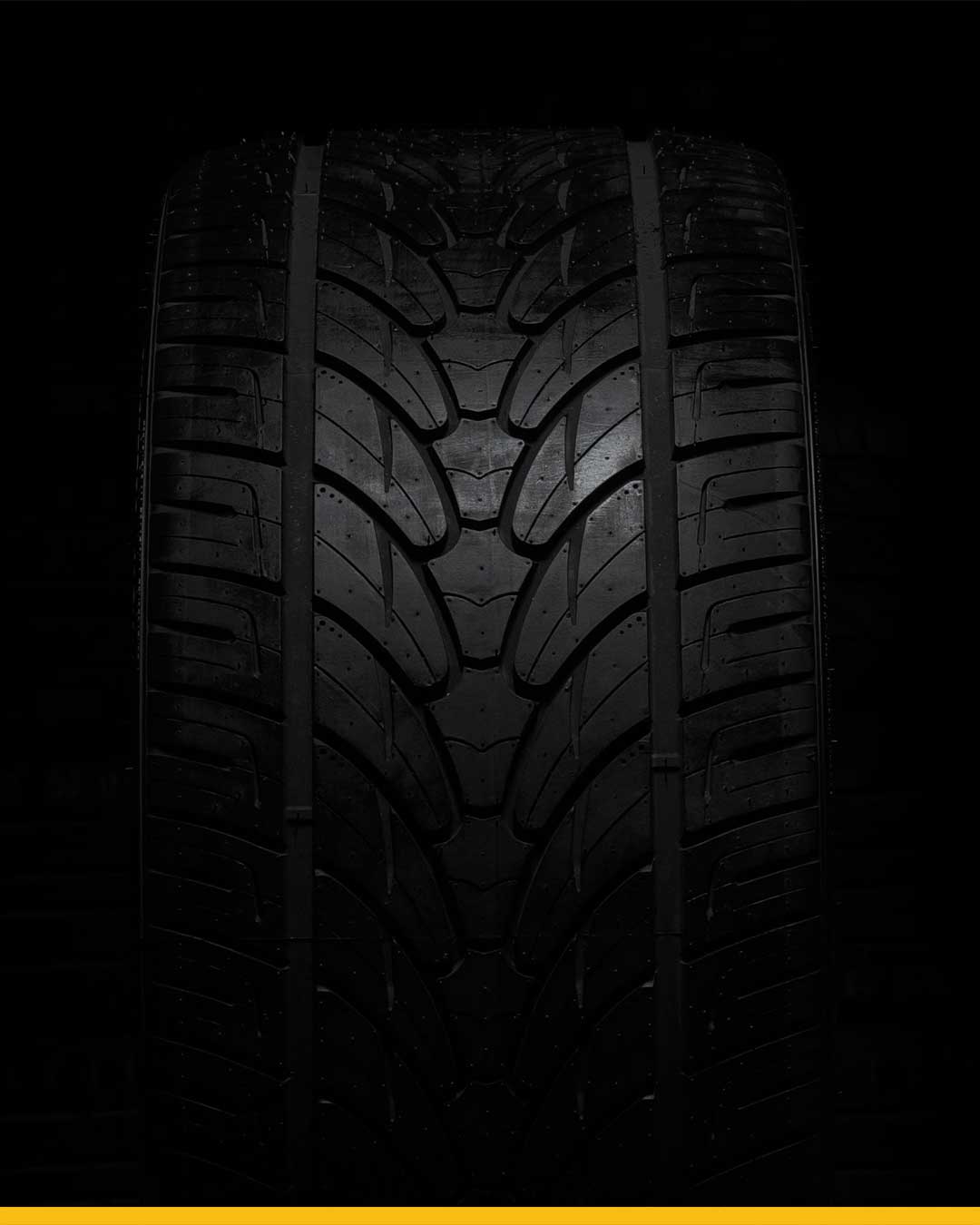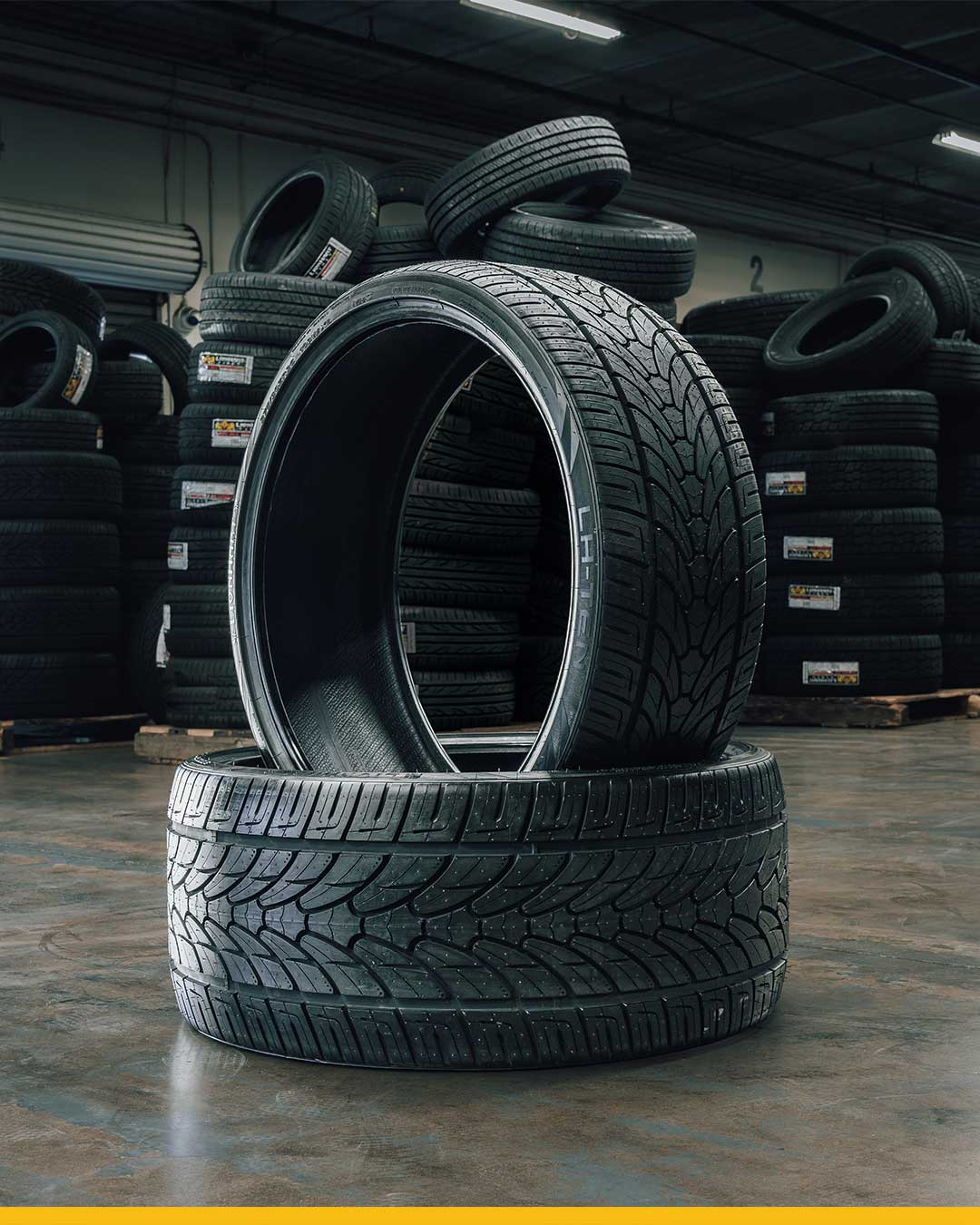How to Read a Tire Sidewall

Tire sizing information molded on the tire sidewall provides significant information about the tire. Learning how to decode tire markings enables you to better understand the tire’s intended purpose, dimensions, load capacity, speed and more. Having this knowledge helps you make a much more informed decision when shopping for tires.
Service Type or Size Designation
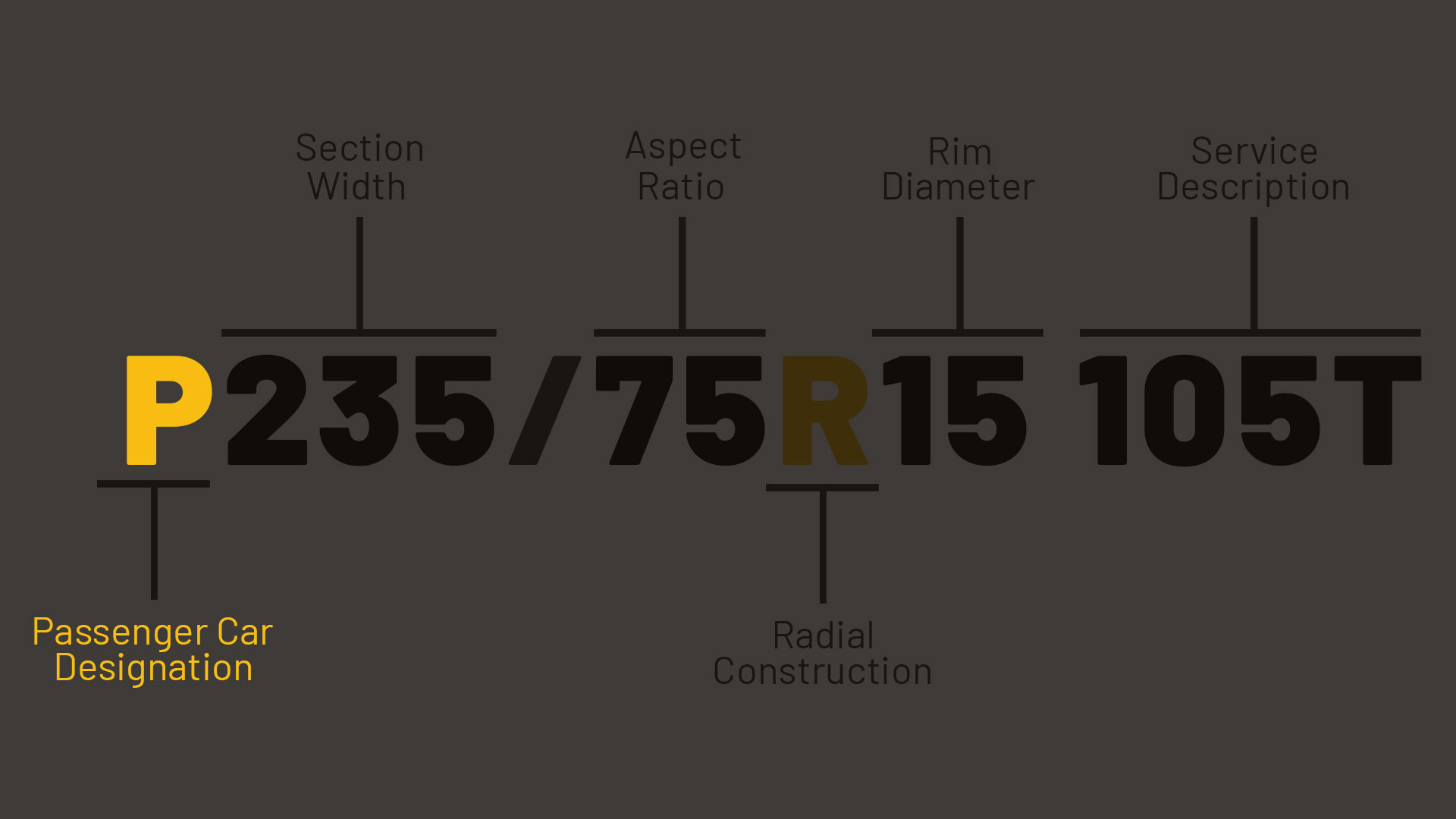
Sometimes you’ll find that size designations start with a letter(s). These letters identify the type of vehicle and/or type of service for which the tires were designed. The typical letter for passenger and light truck tires would read P, LT, T, C and ST.
- P: Passenger Car
- LT: Light Truck
- T: Temporary (restricted usage for “space-saver” spare wheels)
- C: Commercial
- ST: Special Trailer
Passenger tires that are designed based on the Tire and Rim Association’s (TRA) standard start with the letter P and are known as P-metric size tires.
Light Truck tires based on the TRA’s standard often start with two letters: LT. LT signifies that the tire is a light-truck-metric size that was specifically designed to be used on pickup trucks, which have higher cargo carrying and towing capabilities in comparison to a passenger car.
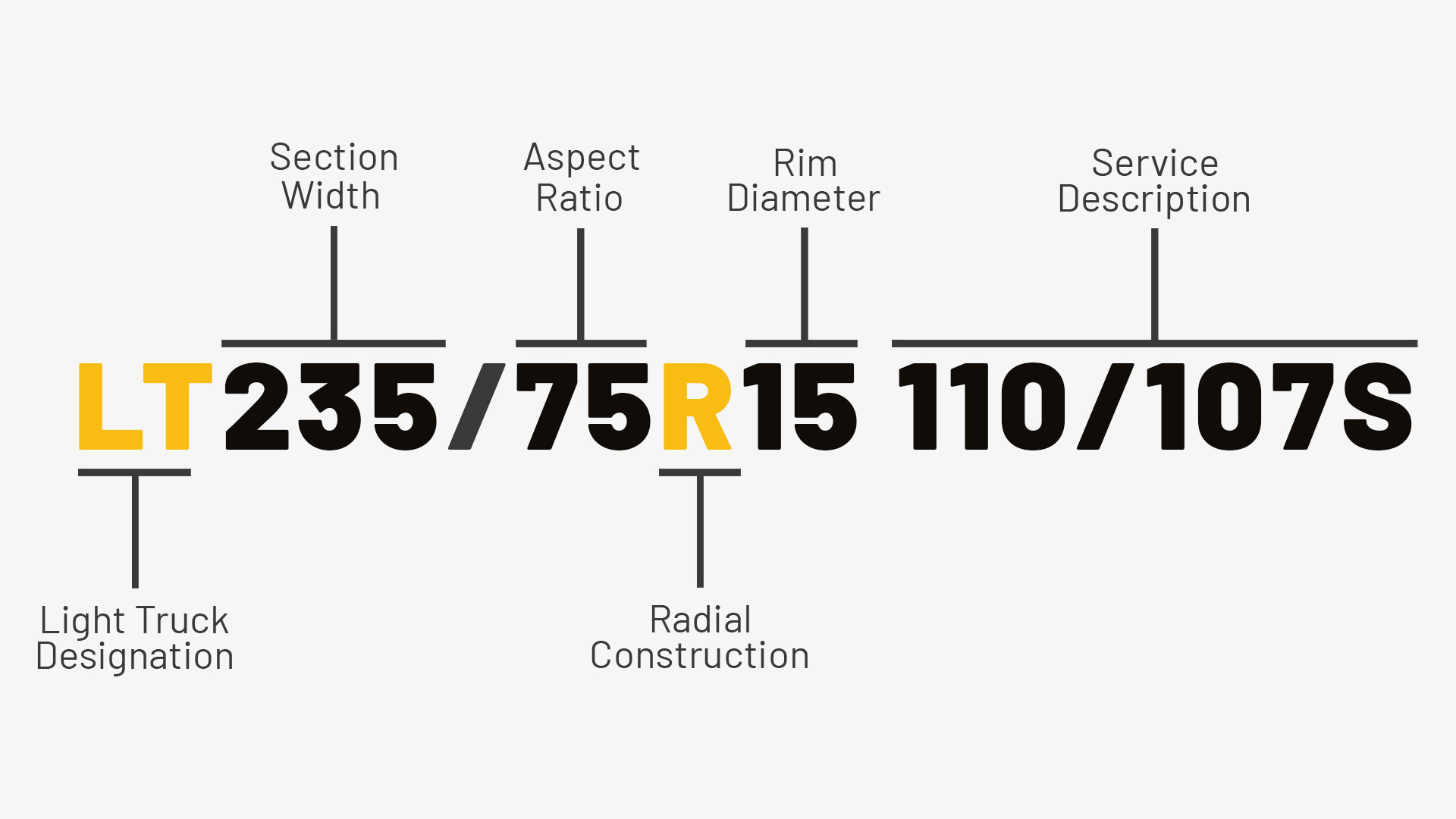
*Note: older sizing conventions use the LT marking at the end of a tire size. These are known as flotation light truck sizes. An example of this type of sizing convention is 37×12.50R17LT.
Tire sizes that begin with the letter T signify that the tire is a temporary spare or mini-spare. These types of tires are designed to be used temporarily until a flat tire can be repaired or replaced.
Although uncommon, tire sizes that end with the letter C are designed for carrying heavy cargo or towing trailers. The letter C signifies that the tire uses a commercial tread, intended for vans or delivery trucks capable of carrying heavy loads. An example of this is 205/75R15C.
Tire size markings that include the letters ST have similar usage as tires that end with C. The difference between the two is the load capacity or load index.
Section Width & Aspect Ratio
This three-digit number identifies the tire’s section width in millimeters. Note that the actual tire may not match perfectly to this number, but it is very close.
The two-digit number following the section width identifies the tire’s aspect ratio. Aspect ratio is identified as a percentage of the section height divided by the section width. Simply put, the aspect ratio number determines the height or tallness of the sidewall.
Following the aspect ratio percentage, you may notice a letter. Typically this letter is an R. The letter R identifies the tire’s construction as a radial tire. In some instances, you may notice the letter D. The letter D identifies a bias ply construction, meaning the plies crisscross on a diagonal.
Additionally, you may notice the letters ZR following the aspect ratio. The Z in ZR corresponds to an old label to indicate that the speed index is higher than V. Thus, a ZR tire has a speed index of V, W or Y. The R in ZR still refers to a radial construction tire.
Lastly, the final two digits in the tire size refer to the diameter of the wheel or rim that the tire is intended to fit.
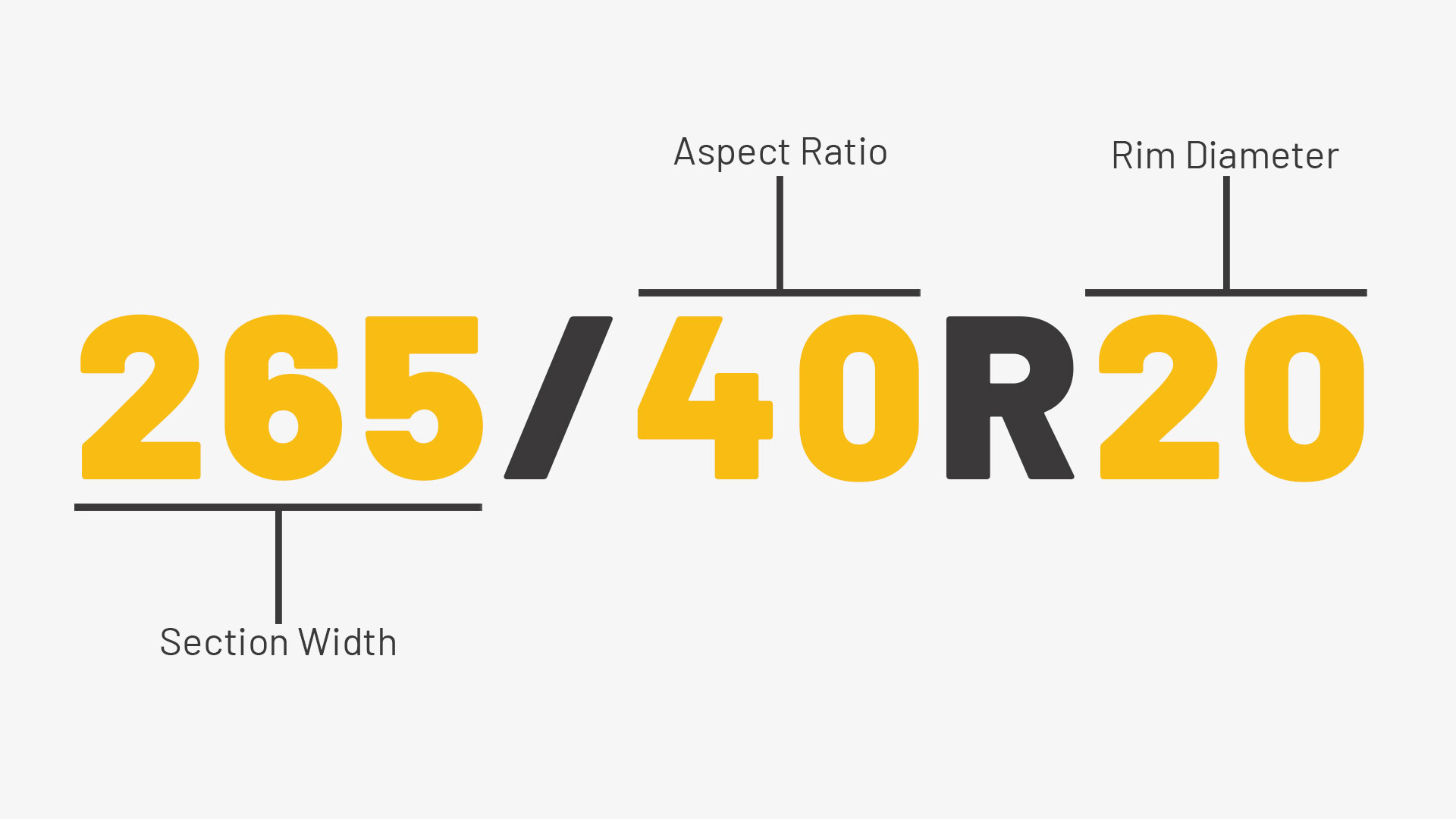
Service Descriptions
The two- or three-digits after the wheel or rim diameter, along with a letter next to it, are known as service descriptions. Service descriptions show the load index of a tire, which defines the maximum loading capacity of a tire, along with the speed rating, which determines the maximum speed allowed on the tire.
The table below shows the typical passenger tire load index ratings along with the maximum loading capacity. The maximum load capacity at maximum pressure (PSI) is also available on the tire’s sidewall.
Additionally, tires are also identified as light load (LL), standard load (SL) or extra load (XL), which can also be found via tire markings.
| Load Index | Max. Load Capacity (lbs) | Load Index | Max. Load Capacity (lbs) | Load Index | Max. Load Capacity (lbs) |
|---|---|---|---|---|---|
| 70 | 739 | 89 | 1,279 | 108 | 2,205 |
| 71 | 761 | 90 | 1,323 | 109 | 2,271 |
| 72 | 783 | 91 | 1,356 | 110 | 2,337 |
| 73 | 805 | 92 | 1,389 | 111 | 2,403 |
| 74 | 827 | 93 | 1,433 | 112 | 2,469 |
| 75 | 853 | 94 | 1,477 | 113 | 2,535 |
| 76 | 882 | 95 | 1,521 | 114 | 2,601 |
| 77 | 908 | 96 | 1,565 | 115 | 2,679 |
| 78 | 937 | 97 | 1,609 | 116 | 2,756 |
| 79 | 963 | 98 | 1,653 | 117 | 2,833 |
| 80 | 992 | 99 | 1,709 | 118 | 2,910 |
| 81 | 1,019 | 100 | 1,764 | 119 | 2,998 |
| 82 | 1,047 | 101 | 1,819 | 120 | 3,086 |
| 83 | 1,074 | 102 | 1,874 | 121 | 3,197 |
| 84 | 1,102 | 103 | 1,929 | 122 | 3,307 |
| 85 | 1,135 | 104 | 1,984 | 123 | 3,417 |
| 86 | 1,168 | 105 | 2,039 | 124 | 3,527 |
| 87 | 1,201 | 106 | 2,094 | 125 | 3,638 |
| 88 | 1,235 | 107 | 2,149 | 126 | 3,748 |
Light Truck Load Range
On the other hand, light truck tires are identified by load range, which varies from the letter B to the letter F. Most of the light truck tires on the market today are load range C, D and E. The table below shows load ranges, ply ratings, and maximum load pressure.
It is important to note that you should never exceed the maximum vehicle load limit listed on the vehicle’s placard or in the owner’s manual. Equally as important, is to never exceed the load carrying limits molded into the tire’s sidewall. Overloading can cause excessive heat, internal structural damage and tire failure.
| Load Range | Ply Rating | Max. Load Pressure |
|---|---|---|
| B | 4 | 35 PSI |
| C | 6 | 50 PSI |
| D | 8 | 65 PSI |
| E | 10 | 80 PSI |
| F | 12 | 95 PSI |
Tire Speed Ratings
The table below illustrates the speed capability of tires. Tire speed ratings were established to match the speed capability of tires with the top speed of the vehicles to which they are applied. Speed rating does not suggest the speed of the vehicle, it only shows the maximum capacity of the tire.
| Rating | MPH | KPH |
|---|---|---|
| A1 | 3 | 5 |
| A2 | 6 | 10 |
| A3 | 9 | 15 |
| A4 | 12 | 20 |
| A5 | 16 | 25 |
| A6 | 19 | 30 |
| A7 | 22 | 35 |
| A8 | 25 | 40 |
| B | 31 | 50 |
| C | 37 | 60 |
| D | 40 | 65 |
| E | 43 | 70 |
| F | 50 | 80 |
| G | 56 | 90 |
| J | 62 | 100 |
| K | 62 | 110 |
| L | 75 | 120 |
| M | 84 | 130 |
| N | 87 | 140 |
| P | 94 | 150 |
| Q | 100 | 160 |
| R | 106 | 170 |
| S | 112 | 170 |
| T | 118 | 190 |
| U | 124 | 200 |
| H | 130 | 120 |
| V | 149 | 240 |
| Z | 149+ | 240+ |
| W | 168 | 270 |
| (W) | 168+ | 270+ |
| Y | 186 | 300 |
| (Y) | 186+ | 300+ |
Warning
Underinflation or overloading of a tire can cause excessive heat and internal structural damage. Overinflation can cause tires to be cut, punctured or broken by sudden impact. These conditions may cause tire failure, including a tread or belt separation and can cause serious harm.
UTQG Markings
The Department of Transportation (DOT) and National Highway Traffic Safety Administration (NHTSA) developed the Uniform Tire Quality Grading (UTQG) standard to help consumers make a more informed decision when shopping for tires. All tires sold from 1979 to present are required to have a UTQG marking on the tire’s sidewall. The UTQG markings consist of treadwear, traction and temperature information.
Treadwear
The treadwear markings identify the longevity of a tire. Treadwear markings have a range between 100 and 1000. So for example, a 1000 UTQG tire will last twice as long as a 500 UTQG tire. Treadwear performance is evaluated on a specific road course that stretches approximately 400 miles in length. This course is established by the NHTSA and is designed to produce treadwear ratings that are generally representative of those encountered by tires in real-world driving conditions.
Traction
Traction markings indicate how well a tire can perform in wet driving conditions. Traction ratings can be AA, A, B or C. The AA rating is the highest level of wet condition performance, whereas the C rating is the lowest. The chart below shows the wet traction coefficient on two different surfaces.
| Grades | G-Force (Asphalt) | G-Force (Concrete) |
|---|---|---|
| AA | >0.54 | 0.38 |
| A | >0.47 | 0.35 |
| B | >0.38 | 0.26 |
| C | <0.38 | 0.26 |


